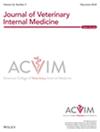Hepatic Dearterialization for Nonresectable Liver Tumors in Five Dogs and Two Cats
Abstract
Introduction
Some massive or nodular liver tumors can make surgical resection dangerous. Transarterial embolization and chemoembolization recently have been evaluated in dogs and cats, but multinodular or diffuse tumors make selective embolization difficult, impractical, and may require multiple anesthetic events. Hepatic dearterialization in humans has been shown to be safe and sometimes successful in promoting temporary tumor regression.
Materials and Methods
Retrospective review of patients with nodular, diffuse, or non-resectable massive liver tumors that underwent transarterial coil embolization of the hepatic artery from the origin of the gastroduodenal artery to the proximal hepatic artery was performed. Data recorded included patient signalment, clinical signs, serum biochemical changes, cross-sectional imaging results, complications, and response to treatment.
Results
Seven patients (five dogs and two cats) underwent transarterial hepatic dearterialization and were included. All patients had increased pretreatment hepatocellular enzyme activities 24 h after surgery. All patients survived to discharge and five were discharged within 24 h after treatment. Two patients experienced mild short-term vomiting and anorexia, one of which required repeat hospitalization. Repeat laboratory testing approximately 6 weeks after treatment indicated decreased ALT and AST activities in 5/6 and 4/5 patients, respectively. Repeat imaging identified tumor regression in 3/4 patients evaluated by computed tomography (CT). Survival time ranged from 50 to 505 days.
Conclusion
Hepatic dearterialization should be further investigated as a palliative management option for multinodular and diffuse liver tumors because it may provide a minimally invasive, safe, and palliative option based on the observation that all patients survived to discharge and tumor regression was noted in three animals.


 求助内容:
求助内容: 应助结果提醒方式:
应助结果提醒方式:


